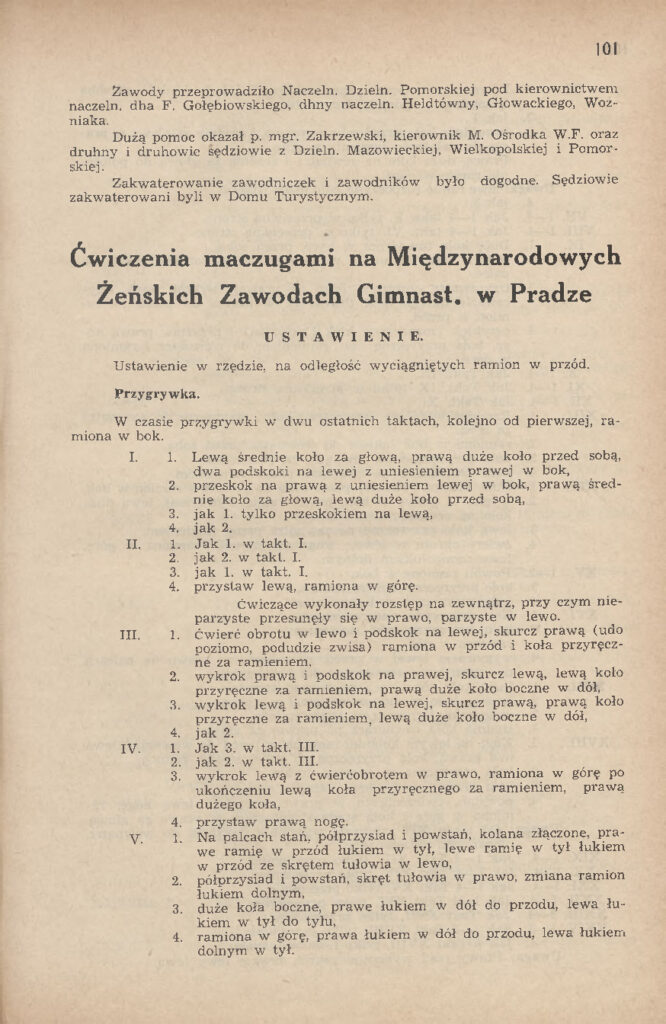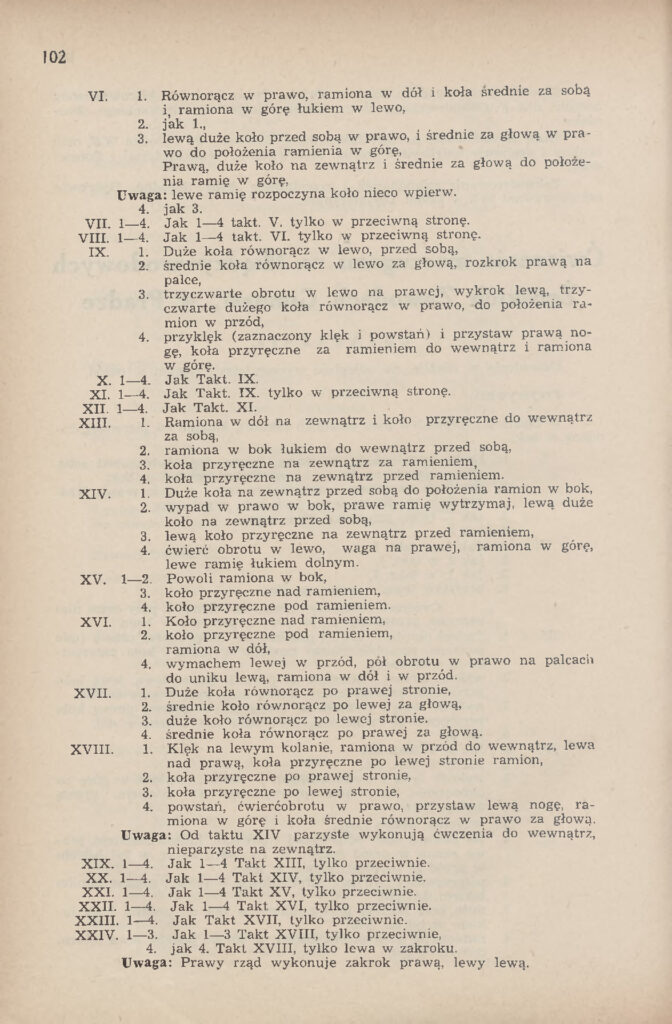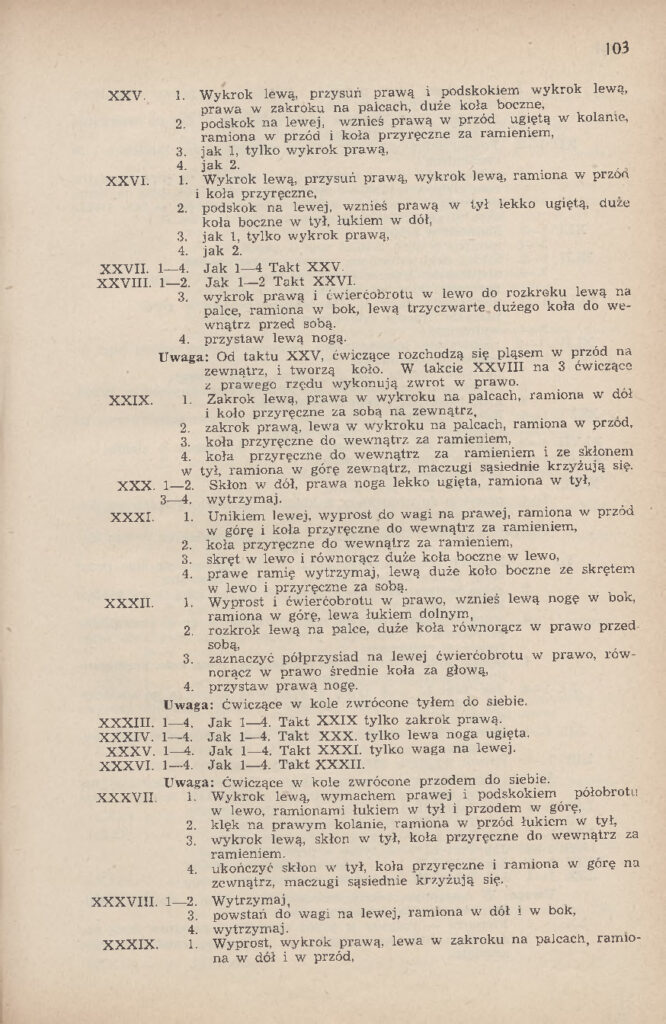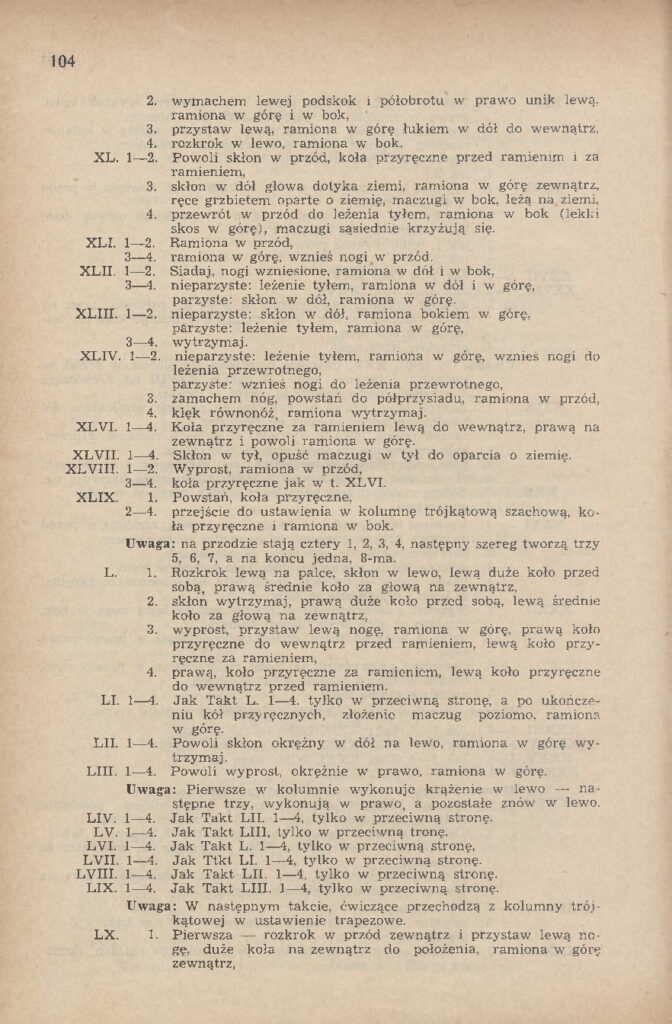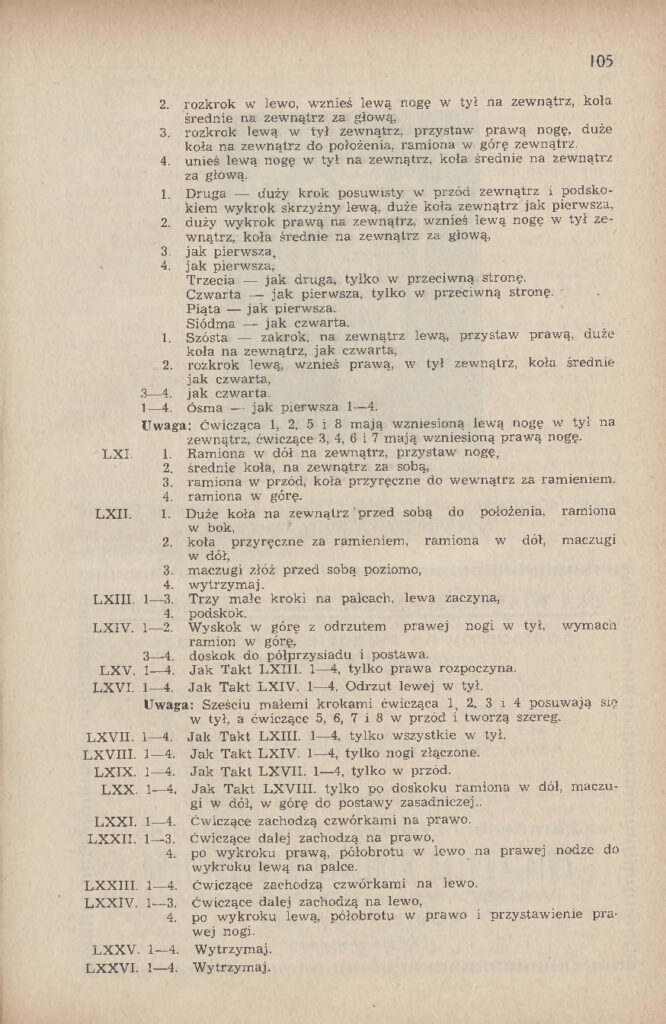The women’s competition at the 1928 Olympic Games was solely a team competition. As was the women’s competition at the 1934 World Championships. As was the women’s competition at the 1936 Olympic Games.
At the 1938 World Championships, in addition to the team results, a women’s individual all-around champion was crowned for the first time at a major FIG competition. (Note: Previously, there had been individual champions at competitions like the Workers’ Olympics, which were unaffiliated with the FIG.)
Let’s take a look at what happened on June 30 and July 1.
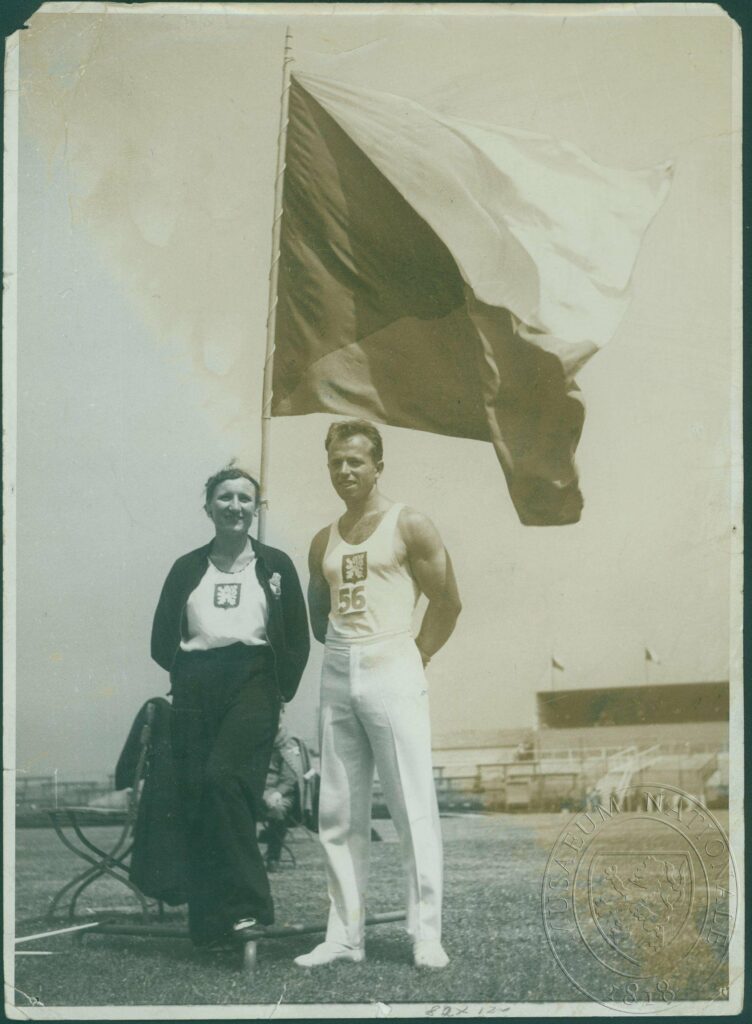
Historical Context | The Team Members | The Program | Apparatus Norms | Scoring | Compulsory Routines | Results | Meet Commentary | Appendix: The Polish Team’s Club Routine
Historical Context
While World War II had not officially begun, the world was expecting Hitler to invade its neighboring countries, including Czechoslovakia. So, it’s not surprising that many countries turned down their invitations to compete at the 1938 World Championships in Prague.
Reports out of Moscow on May 28, 1938, underscored the clear and present danger of the political situation in Czechoslovakia:
Soviet spokesmen have continued to evince concern all week over the possibilities of a general war blazing up from the Czechoslovakia situation. As seen here the emergency is less urgent than it was last week but the powder barrel stays open.
NYTimes, May 28, 1938
Czechoslovakia was seen as a powder keg, waiting to explode.
Weeks later, when the Yorkshire Post and Leeds Intelligencer wrote about the gymnastics rally in Prague, the newspaper described the situation in Czechoslovakia as the “gravest crisis experienced since the foundation of Czechoslovakia.”
In the midst of the gravest crisis experienced since the foundation of Czechoslovakia, Prague is celebrating the tenth Congress of the Slavonic Gymnastic Movement called the Sokol, or Falcon.
Yorkshire Post and Leeds Intelligencer, July 6, 1938
So, which countries ended up participating?
- Bulgaria
- Czechoslovakia
- Poland
- Yugoslavia
TCH: The Czechoslovaks were disappointed that more countries didn’t attend.
Only one thing they were not that happy about. The Hungarians, who were an excellent team in Budapest and Berlin, and the Germans, who were 0.5% ahead of our team in Berlin, did not have their strong competitors here. Both teams were registered for the competition and withdrew only at the last minute. The Dutch team apologized on the eve of the competition and did not participate.
Sokol (Czechoslovakia), 1938, 6-8
Že tu neměly své silné konkurentky Maďarky, které byly výborným družstvem v Budapešti i Berlíně, a Němky, které naše družstvo předstihly v Berlíně o 0.5%. Obě družstva byla k závodům přihlášena a odřekla teprve v poslední chvíli. Družstvo Holanďanek se omluvilo v předvečer závodů.
TCH: But since it was a competition of Slavic countries, there was a sense of mutual understanding.
Thus, coincidentally, during the 10th famous Sokol Rally, only Slavic teams meet, and thus the international competition becomes a race of the Association of Slavic Sokol. It was a competition of sisters, so there was no misunderstanding; no exaggerations were seen; on the contrary, very often, the judges ultimately agreed with one another. The competitors and the judges were real sisters, as it should be at the Sokol races. That’s why there was no nervousness, no grief, as there was at the Olympics in Berlin.
Sokol (Czechoslovakia), 1938, 6-8
Tak shodou okolností při X. slavném sletu všesokolském schází se družstva jedině slovanská a tím mezinárodní závod stává se závodem Svazu slovanského sokolstva. Byl to sesterský závod, proto nepřišlo k žádnému nedorozumění; nebylo viděti žádné přehnané známky, naopak velmi často se soudkyně úplně shodly. Proto nebylo té nervosity, zármutku, jak tomu bylo na Olympiadě v Berlíně.
Note: In December of 1937, there was an official competition of Slavic Sokol associations in Novi Sad, Yugoslavia. Vlasta Foltová won the all-around with a 74.20. Zdena Veřmiřovská was second with a 74.10. Vlasta Děkanová was third with a 73.90. Matylda Palfvová was fourth with a 73.50. (Source: Sokolski Glasnik, January 1, 1938)
The Team Members
Czechoslovakia
Vlasta Děkanová from Žižkov, Zdena Veřmiřovská and Matylda Palfvová from Bratislava, Božena Dobešová from Bílovice, Vlasta Foltová from Vinohrady; new members were Marie Skálová from Č. Třebová, Hana Nežerková from Tornaľa from Slovakia and Marie Hendrychová.
Sokol (Czechoslovakia), 1938, 6-8
V. Děkanová ze Žižkova, Zdena Veřmiřovská a M. Palfvová z Bratislavy, B. Dobešová z Bílovic, V. Foltová z Vinohrad; nové byly M. Skálová z Č. Třebové, Hana Nežerková z Tornalje ze Slovenska a M. Hendrychová.
Note: I added the gymnasts’ first names to the English translation.
Poland
The women’s team went to the competition consisting of: Skirlińska, Stępińska, Wajsna, Łuczyńska, Osadnikówna, Wojciechowska, Majowska and Noskiewiczówna.
Sokół (Poland), 1938, number 9
Na zawody wyjechała drużyna żeńska w składzie: Dhna Skirlińska, Stępińska, Wajsówna, Łuczyńska, Osadnikówna, Wojciechowska, Majowska i Noskiewiczówna.
Yugoslavia
Elza Kovačič, Marta Pustišek, Jelica Vazaz, Lidija Rupnik, Milena Sket, Anica Hafner, Marta Podpac, Dušica Radivojevič.
Sokolski Glasnik, 1938, numbers 26-29
Which events?
Ensemble
- Rhythmic gymnastics with clubs
Compulsory Routines
- Uneven Bars
- Flying Rings
Optional Routines
- Uneven Bars
- Balance Beam
- Vault
Track and Field
- 60 m sprint: 10 points for 8.8 seconds
- Discus throw: 10 points for 26 m
Source for athletics scoring: Sokol (Yugoslavia), 1937, number 12
Apparatus Norms
Uneven Bars
Bars with unequal poles, the higher pole at a height of 230 cm, the lower – at 150 cm.
Dodatek Techniczy do Przewodnika Gimnastycznego “Sokoł,” 1938, N. 3
Poręcze o nierównych żerdziach, wyższa żerdź na wysokości 230 cm., niższa — na 150 cm.
Reminder: At the 1934 World Championships, the women had the choice of uneven bars or parallel bars. At the 1936 Olympics, the compulsory routine was on uneven bars, and the optional routine could be performed on parallel bars or uneven bars.
Flying Rings
Rings at the height of the swing.
Dodatek Techniczy do Przewodnika Gimnastycznego “Sokoł,” 1938, N. 3
Kółka na wysokości dosiężnej, huśtaniem.
Note: The rings would have likely been performed on the men’s rings, the dimensions of which were fairly standardized by 1938: A portico of 5.50 m. Wood rings with an 18 cm diameter and 28 mm thickness. (Handbook of Sports Regulations, Gymnastics, 1936 Olympics).
Scoring?
Here are the point values:
Compulsory routines: Out of 10
Optional routines: Out of 15
Athletics: Out of 10
Club Routines: Out of 70
The maximum score for individual AA: 85 points
The maximum score for the team: 580 points
The team score was based on the six best all-around scores per team in addition to the ensemble club routine.
What were the compulsory routines?
Here are the English summaries from Olympische Turnkunst.
Flying Rings
The rings exercise was simple: once swinging in bent-arms hang, once in L-position hang, once in inverted hang and dismounting with straight body from the hang.
Olympische Turnkunst, 1973, Number 1
Uneven Bars
The most difficult parts of the uneven bars exercise was swing down from outward front support on the high bar to felge on the low bar with grip change and, later, from front transverse hang, with both hands grasping the high bar and the legs on the low bar, two — leg circle round and along the low bar. The dismount was a cast from the high bar across the low bar.
Olympische Turnkunst, 1973, Number 1
Results
Team Results
Czechoslovakia defended its 1934 title and dominated the competition in the process, posting the highest scores in every event.
| Event | 1. TCH | 2. YUG | 3. POL | 4. BUL |
| UB-C | 50.80 | 43.75 | 47.45 | 13.85 |
| UB-O | 87.20 | 84.35 | 87.10 | 60.40 |
| FR-C | 57.25 | 50.65 | 57.15 | 35.15 |
| BB-O | 86.9 | 78.85 | 82.35 | 60.45 |
| VT-O | 88.11 | 86.71 | 84.96 | 63.64 |
| 60 m | 58.00 | 57.00 | 44.00 | 2.00 |
| Discus | 56.90 | 50.90 | 43.10 | 3.60 |
| Clubs | 67.60 | 61.75 | 64.10 | 47.25 |
| Total | 552.76 | 513.96 | 510.21 | 286.34 |
UB-C: Uneven Bars – Compulsories; UB-O: Uneven Bars – Optionals; FR-C: Flying Rings – Compulsories; BB-O: Balance Beam – Optionals; VT-O: Vault – Optionals
Individual All-Around
Děkanová has the honor of being crowned the first World or Olympic All-Around Champion in women’s gymnastics.
Sister Vlasta Děkanová thus became the first world champion in women’s gymnastics. In previous competitions, only teams were awarded; the champion’s name was not announced at all. She deserved to be the best due to her versatility and competitive reliability, gained by diligent and persistent preparation for all significant Sokol and international races in the last ten years.
X. všesokolský slet v Praze 1938
Stala se tedy první světovou přebornicí v ženském tělocviku sestra Vlasta Děkanová. V dřívějších závodech byla oceňována jen družstva, název přebornice nebyl udělován. Zasloužila si ho dobře svou všestranností a závodní spolehlivostí, získanou pilnou a vytrvalou přípravou na všechny velké závody sokolské i mezinárodní za posledních deset let.
Note: The Yugoslav federation’s publication also indicated that this was the first time there was an individual world champion was crowned in women’s gymnastics: “Po prvi put se računalo i pojedinačno svetsko prvenstvo, tako da je prva p rvakinja sveta u telesnom vežbanju.” (Sokol Glasnik, 1938, 26/29).
| Gymnast | Ctry | UB-C | UB-O | FR-C | BB-O | VT-O | 60 m | Discus | Total |
| 1. Děkanová | TCH | 9.65 | 14.85 | 9.50 | 14.90 | 14.76 | 10.00 | 10.00 | 83.66 |
| 2. Veřmiřovská | TCH | 9.40 | 14.10 | 9.90 | 14.55 | 14.76 | 10.00 | 10.00 | 82.71 |
| 3. Palfyová | TCH | 7.95 | 14.75 | 9.95 | 14.70 | 14.83 | 10.00 | 9.80 | 81.98 |
| 4. Skirlińska | POL | 8.15 | 14.70 | 9.65 | 14.40 | 13.40 | 10.00 | 10.00 | 80.30 |
| 5. Skálová | TCH | 7.35 | 14.70 | 9.20 | 14.25 | 14.60 | 10.00 | 10.00 | 80.10 |
| 6. Nežerková | TCH | 7.95 | 14.50 | 9.25 | 14.15 | 14.73 | 10.00 | 8.30 | 78.88 |
| 7. Rupnik | YUG | 8.60 | 13.75 | 8.65 | 13.40 | 14.46 | 10.00 | 10.00 | 78.86 |
| 8. Hafner | YUG | 9.25 | 14.70 | 8.75 | 14.20 | 14.50 | 10.00 | 7.30 | 78.70 |
| 9. Hendrychová | TCH | 8.50 | 14.30 | 9.45 | 14.35 | 14.43 | 8.00 | 8.80 | 77.83 |
| 10. Bobešová | TCH | 8.80 | 14.80 | 9.70 | 11.60 | 14.66 | 9.00 | 8.40 | 76.96 |
UB-C: Uneven Bars – Compulsories; UB-O: Uneven Bars – Optionals; FR-C: Flying Rings – Compulsories; BB-O: Balance Beam – Optionals; VT-O: Vault – Optionals
Note: The official proceedings from the Sokol rally list Bobešová’s all-around total incorrectly.
The Top Scores on Each Event
Extant articles do not indicate that there were apparatus awards — just team and all-around awards. So, there wasn’t a gold medalist on, say, compulsory flying rings in 1938. Apparatus awards wouldn’t appear in women’s artistic gymnastics until the 1950 World Championships.
With that caveat out of the way, here were the top scores in each discipline.
Note: When the FIG printed first printed individual results in men’s gymnastics at the World Championships (called the International Tournament at the time), the year was 1922, and they started with the all-around. Apparatus winners came later, in 1934.
Flying Rings — Compulsories
| Gymnast | Country | Score |
| 1. Palfyová | TCH | 9.95 |
| 2. Veřmiřovská | TCH | 9.90 |
| 3T. Foltová | TCH | 9.80 |
| 3T. Noskiewiczówna | POL | 9.80 |
Balance Beam — Optionals
| Gymnast | Country | Score |
| 1. Děkanová | TCH | 14.90 |
| 2. Sket | YUG | 14.76 |
| 3. Foltová | TCH | 14.75 |
Uneven Bars — Compulsories
| Gymnast | Country | Score |
| 1. Děkanová | TCH | 9.65 |
| 2. Veřmiřovská | TCH | 9.40 |
| 3. Hafner | YUG | 9.25 |
Uneven Bars — Optionals
| Gymnast | Country | Score |
| 1. Děkanová | TCH | 14.85 |
| 2T. Foltová | TCH | 14.80 |
| 2T. Dobešová | TCH | 14.80 |
Vault — Optionals
| Gymnast | Country | Score |
| 1T. Palfyová | TCH | 14.83 |
| 1T. Majowska | POL | 14.83 |
| 3T. Sket | YUG | 14.76 |
| 3T. Děkanová | TCH | 14.76 |
| 3T. Bobešová | TCH | 14.76 |
60 M
| Gymnast | Country | Time (seconds) |
| 1. Kovačič | YUG | 8.30 |
| 2. Děkanová | TCH | 8.40 |
| 3. Palfyová | TCH | 8.50 |
Discus
| Gymnast | Country | Distance (meters) |
| 1. Sket | YUG | 30.23 |
| 2. Děkanová | TCH | 29.80 |
| 3. Skálová | TCH | 28.15 |
Competition Commentary
Preparation
TCH: The Czechoslovak team took this seriously and had the expectations of the country on their shoulders.
For the first time in women’s gymnastics history, there was international women’s competition in Prague. While witnessed by the whole nation, the eight best of our women defended the first places of the Sokols and defended the primacy of our nation. They knew well what the nation expected of them; they were fully aware of their responsibilities: to improve the results of the Olympics and regain the first place they had achieved in Budapest already in 1934. They prepared well; they have been training since the Olympics, didn’t participate in any winter sports, and didn’t go to any parties. Sunday after Sunday, they met in Prague and Brno, consulted with each other, became one family, which followed the success of each member in proper preparation.
Sokol (Czechoslovakia), 1938, 6-8
Po prvé v dějinách ženského tělocviku byly mezinárodní závody žen v Praze. Před očima vlastního národa hájilo osm nejlepších našich žen nejen prvých míst Sokola, ale obhajovalo prvenství národa. Věděly dobře, co od nich národ očekává, byly si plně vědomy své povinnosti: předhonit výsledky z Olympiády a znovu získat prvého místa, kterého dosáhly v Budapešti v r. 1934. Připravovaly se poctivě; od olympijských her věnovaly se přípravě, neznaly krásu zimních sportů, nehonily se za zábavami. Neděli co neděli se scházely v Praze a Brně, navzájem si radily, stala se z nich jedna rodina, která v poctivé přípravě sledovala zdar každé jednotlivé.
Flying Rings
TCH: The Bulgarians struggled. The Yugoslavs could have been more lively.
The competition started with a compulsory exercise with rings. The exercise was presented well, apart from the Bulgarians, who are just at the beginning of the race and were led by a man. Only the Yugoslavians could have contributed more liveliness in this exercise.
Sokol (Czechoslovakia), 1938, 6-8
Závody začaly povinnou sestavou na kruzích. Mimo Bulharky, které jsou v začátcích závodění a které byly vedeny mužem, byla kruhová sestava cvičena dobře. Jen Jihoslovankám by bylo přispělo více živosti na kruzích.
Uneven Bars – Compulsories
HUN: According to Nagy, the Czechoslovak team struggled with the mandatory dismount.
On the rings there were almost maximum points, on the uneven bars the Czechoslovaks were a little weaker, especially on the mandatory dismount.
Olympische Turnkunst, 1973, Number 1
An den Ringen gab es fast maximale Punkte, am Stufenbarren waren die Tschechoslowakinnen etwas schwächer, besonders bei dem Pflichtabgang.
HUN: According to Nagy, the Bulgarians really struggled on uneven bars, recording a zero.
Bulgaria: The Bulgarian gymnasts were quite weak on all apparatus. They were the worst on the uneven bars in the mandatory exercises. The greatest difficulty for them was the beginning of the exercise. Baeva got the best score with 5.05 points, then three scores were under 3 points and one zero. But the exercises showed that the gymnasts had great talent; but the execution was bad.
Olympische Turnkunst, 1973, Number 1
Bulgarien: Die bulgarischen Turnerinnen waren an allen Geräten ziemlich schwach. Am schlechtesten waren sie am Stufenbarren bei den Pflichtübungen. Die größte Schwierigkeit bedeutete für sie der Beginn der Übung. Die beste Note bekam Baeva mit 5,05 Punkten, dann waren drei Noten unter 3 Punkten und eine Null. Die Kürübungen aber zeigten, daß die Turnerinnen viel Talent besaßen; doch die Ausführung war schlecht.
The scores were lower on compulsory bars. The Czechoslovak publication Sokol listed the top scores for compulsory bars:
Děkanová with 9.65 and Veřmiřovská with 9.40 gain the most points again, followed by Yugoslav Hafner with 9.25 points and Podpac 9.00 points.
Sokol (Czechoslovakia), 1938, 6-8
Nejvíce bodů získává opět Děkanová 9.65 a Veřmiřovská 9.40, za nimi jsou Jihoslovanky Hafner 9.25 b. a Podpac 9.00 b.
Balance Beam – Optionals
HUN: The gymnasts were a bit wobbly.
There was a lot of uncertainty on the balance beam in all teams; countless falls and many serious wobbles occurred. One can still notice that the performances in the warm-up were much better than in the competition itself.
Olympische Turnkunst, 1973, Number 1
Am Schwebebalken war bei sämtlichen Mannschaften viel Unsicherheit zu bemerken; unzählige Stürze und viele schwere Gleichgewichtsfehler kamen vor. Man kann noch bemerken, daß die Leistungen beim Einturnen viel besser ausfielen als beim Wettkampf selbst.
TCH: The Polish gymnasts had their own style but it wasn’t anything new.
The Poles had a lot of rhythmic and even ballet elements on them, which were impressive, but they didn’t bring anything new.
Source: Sokol (Czechoslovakia), 1938, 6-8
Polky měly na ní hodně rytmických, ba baletních prvků, které byly efektní, ale nepřinesly nic nového.
TCH: The Yugoslav gymnasts struggled with their balancing elements.
The Yugoslavs had graceful formations, but they were very insecure in balance exercises, which are very important when exercising on the balance beam.
Source: Sokol (Czechoslovakia), 1938, 6-8
Jihoslávky měly sestavy ladné, ale byly hodně nejisté ve cvicích rovnováhy, které jsou vlastním účelem při cvičení na kladině.
TCH: The Czechoslovak gymnasts were nervous.
Our sportswomen were noticeably but slightly afraid of it after the mandatory [uneven] parallel bars.
Source: Sokol (Czechoslovakia), 1938, 6-8
Na našich cvičenkách byla znát malá ruzrušenost po povinných bradlech.
Uneven Bars – Optionals
TCH: The Czechoslovak gymnasts were exceptional.
Our team performed the optional [uneven] parallel bar exercises professionally and were all of a high standard.
Source: Sokol (Czechoslovakia), 1938, 6-8
Volná bradla byla u našeho družstva volena odborně a všechny byly vysoké úrovně.
TCH: The Polish gymnasts were crowd favorites.
The Poles had a more professional line-up, more likable, with admirable fluency and grace. When performing, they knew well what they liked and the effect.
Source: Sokol (Czechoslovakia), 1938, 6-8
Polky měly sestavy tahové, líbivější, s pěknou plynulostí a ladností. Při sestavení sestav věděly dobře, co se líbí a co dělá efekt.
The Polish publication echoed this sentiment.
It must be admitted that optional exercises of our girls on the balance beam and uneven bars were very popular, they had excellent transitions, were characterized by fluidity and difficulty, but they still lacked an exemplary finish of the exercises.
Sokół (Poland), 1938, number 9
Trzeba przyznać, że dowolne ćwiczenia naszych druhen na równoważni i poręczach cieszyły się dużym zainteresowaniem, miały one doskonałe przejścia, wyróżniały się płynnością i trudnością, ale brakowało im jeszcze wzorowego wykończenia ćwiczeń.
As did Nagy in her retrospective article.
Poland: The freestyle exercises were pleasantly structured. The gymnasts knew very well what was effective to gain the applause of the spectators.
Olympische Turnkunst, 1973, Number 1
Polen: Die Kürübungen waren gefällig aufgebaut. Die Turnerinnen wußten sehr gut, was effektvoll war, um den Beifall der Zuschauer zu erringen.
TCH: The Yugoslav gymnasts swung bars without pausing.
The Yugoslav groups swung a lot without endurance, well-chosen in a quite different style than we are used to.
Source: Sokol (Czechoslovak), 1938, 6-8
Jihoslovanské sestavy byly bez výdrží hodně švihové, dobře voleny v docela jiném stylu, než jsme u nás zvyklé.
Nagy made a similar comment in her 1973 retrospective article.
The freestyle exercises on parallel bars were very different and modern for the time. All the exercises were energetic, and there was no pausing.
Olympische Turnkunst, 1973, Number 1
Die Kürübungen am Barren waren sehr verschieden und für damals modern. Alle Übungen waren schwungvoll, und es gab kein Verharren. Die Jugoslawinnen waren auch in der Leichtathletik gut.
My thought bubble: We always say that Doris Brause was the first gymnast to truly swing bars. But maybe that honor belongs to the Yugoslav gymnasts in 1938. It’s hard to say without video footage of the competition.
Vault – Optionals
TCH: Foltová scored two zeros.
However, this discipline has become fatal for us. Foltová, one of the best sportswomen, left with 0 and thus, the team was deprived of at least 14 points.
Sokol (Czechoslovakia), 1938, 6-8
Toto nářadí se nám však stalo osudným. Foltová, jedna z nejlepších závodnic, odchází s 0 a tím bylo družstvo připraveno nejméně o 14 bodů.
Track and Field
POL: We didn’t prepare enough for the track and field events.
Our result really worried Czech athletes, who were counting on good results from Polish athletes in athletics. Unfortunately, too short preparation in the camp did not allow us to improve athletic results, so on the second day, we started to lose points, which made Yugoslavian girls gain a lot.
Sokół (Poland), 1938, number 9
Wynik nasz bardzo zaniepokoił zawodniczki czeskie, które liczyły się z dobrymi wynikami Polskich zawodniczek w lekkoatletyce. Niestety zbyt krótkie przygotowanie w obozie nie pozwoliło na podniesienie wyników lekkoatletycznych, to też drugiego dnia zaczęliśmy tracić punkty, przez co zyskały znacznie Jugosłowianki.
Note: In 1934, the Polish team also didn’t prepare enough for the track and field events.
Ensemble Exercises with Clubs
HUN: The club routines were moved indoors, which made the music more audible.
Team exercises with clubs: Because of the bad weather, the competition had to be held in a gym. The advantage of this was that you could hear the music better. During these exercises one could observe the different technique of the club exercises.
Olympische Turnkunst, 1973, number 1
Mannschaftsübungen mit Keulen: Wegen des schlecten Wetters mußte der Wettkampf in einer Turnhalle ausgeführt werden. Der Vorteil dabei war, daß man die Musik besser hören konnte. Bei diesen Übungen hat man die verschiedene Technik der Keulenübungen beobachten können.
HUN: Poland’s routine was fantastic, but they needed to use the clubs during their difficult parts.
The Polish women’s club exercise was very dynamic and smooth with many surprising elements and connections. Good execution, nice fitting music! The basic mistake was that the difficult parts were simply done without a club.
Olympische Turnkunst, 1973, number 1
Die Keulenübung der Polinnen war sehr dynamisch und dabei geschmeidig mit vielen überaschenden Elementen und Verbindungen. Gute Ausführung, schöne, passende Musik! Der Grundfehler war, daß die schwierigen Teile einfach ohne Keule durchgeführt wurden.
Note: You can find the complete text of the Polish club routine below. I’ve translated the first couple of sections to give you an idea of what it consisted of.
HUN: Czechoslovakia used their entire bodies when swinging clubs.
The Czechoslovak women’s club exercises were very rich and aesthetic and very valuable in their structure. What was new was that every movement emanated from the whole body. There was exquisite harmony between movement and music, the overall work of the gymnasts was exact and precise.
Olympische Turnkunst, 1973, number 1
Die Keulenübungen der Tschechoslowakinnen waren sehr reichhaltig und ästhetisch und in ihrem Aufbau sehr wertvoll. Neu war dabei, daß jede Bewegung vom ganzen Körper ausging. Es war vorzügliche Harmonie zwischen Bewegung und Musik, die Gesamtarbeit der Turnerinnen war exakt und präzise.
HUN: Bulgaria’s routine was simple.
The Bulgarian women’s club exercises were performed without music, they were simple, easy, well worked out.
Olympische Turnkunst, 1973, number 1
Die Keulenübungen der Bulgarinnen wurden ohne Musik durchgeführt, sie waren einfach, leicht, gut ausgearbeitet.
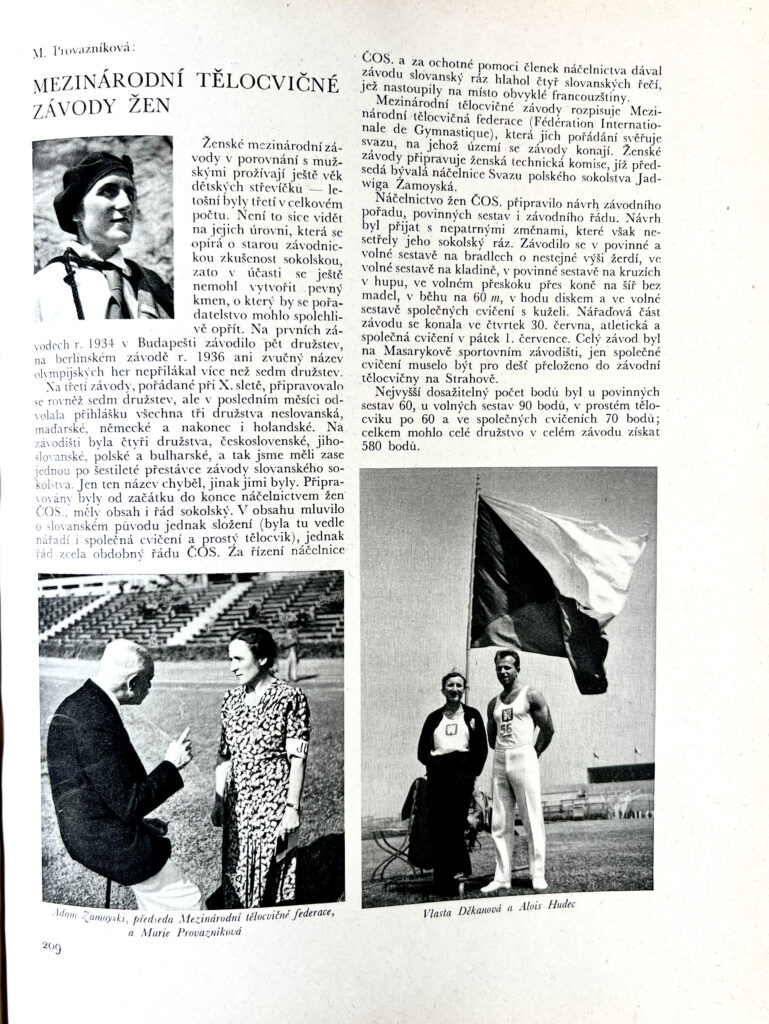
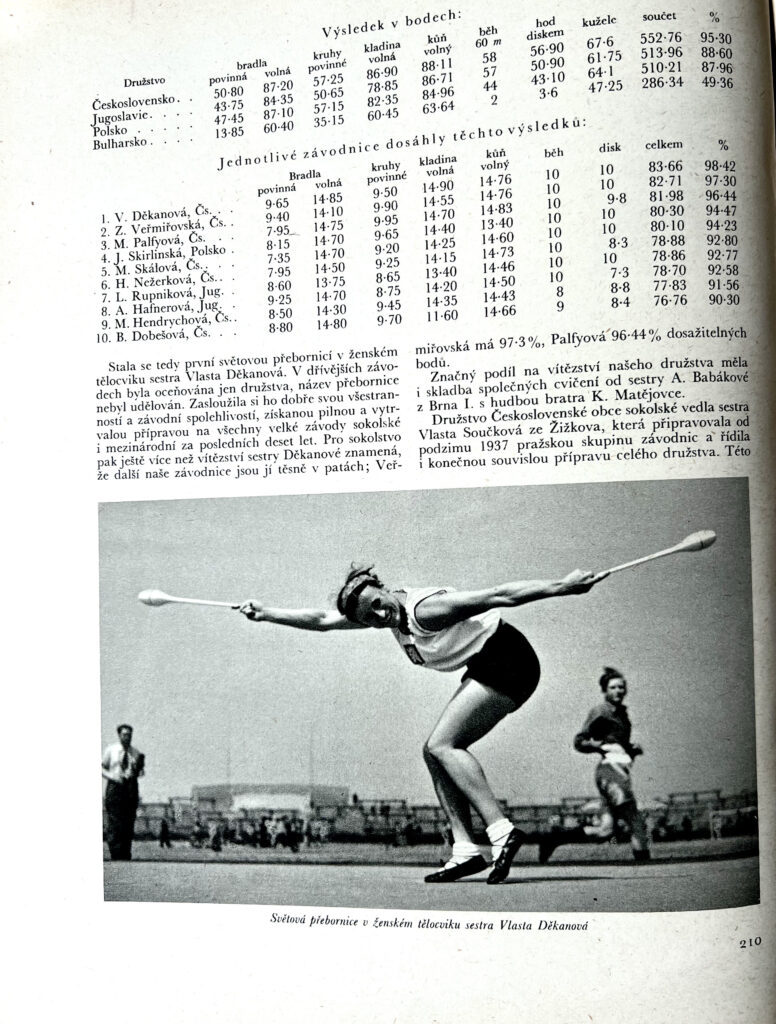
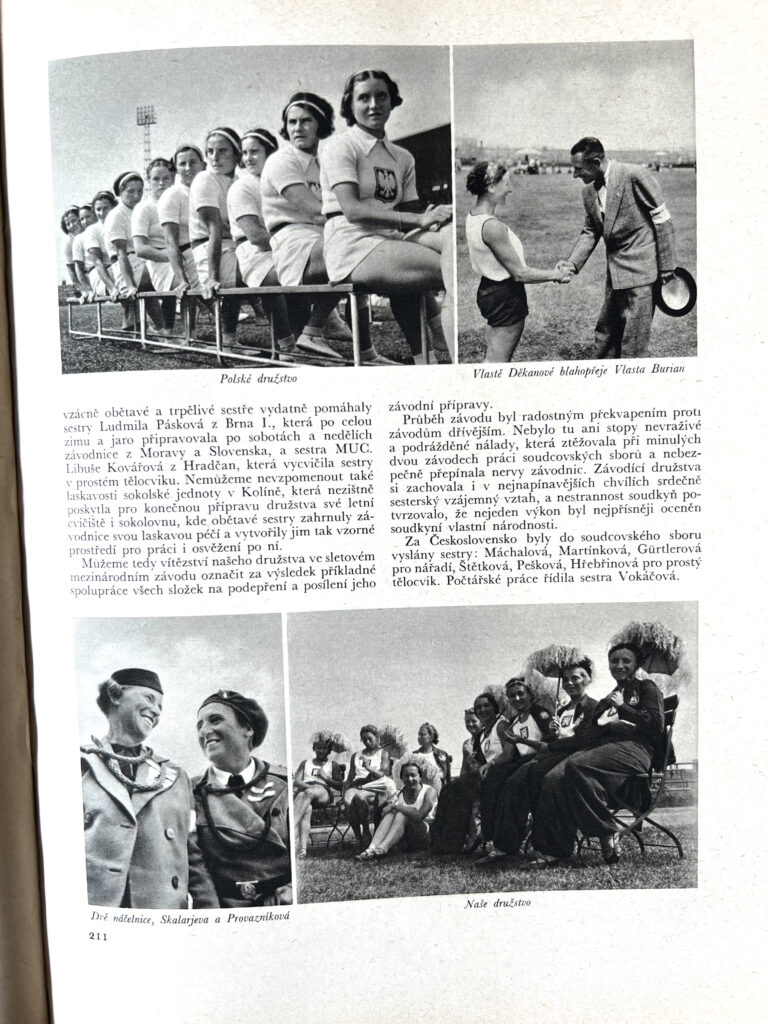
Appendix: Poland’s Club Routine
The following is a translation of part of Poland’s club routine:
Exercise routines with clubs at the International Women’s Gymnastics Competition in Prague
SETUP.
Line up in a row, arms outstretched forward.
Prelude.
During the prelude, in the last two beats, successively from the first, arms out to the side.
I.
1. With your left medium circle behind your head, with your right large circle in front of you, two jumps on your left with your right raised to the side,
2. jump on the right with the left raised to the side, right medium circle behind the head, left large circle in front of you,
3. as 1. only by jumping to the left,
4. as 2.
II.
1. as 1. to the beat. I.
2. as 2. to the beat. I.
3. as 1. to the beat. I.
4. join the left one, arms up.
Athletes performed an outward straddle, with the odd ones moving to the right and the even ones to the left.
III.
1. quarter turn to the left and hop on the left, bend the right (thigh horizontal, shank hanging down) arms out forward and circle the hand behind the shoulder,
2. step out with right and jump up on right, bend the left, left circle behind shoulder, and right large side circle down,
3. step out with left and jump on left, bend the right, right circle behind the shoulder, and left large side circle down,
4. as 2.
IV.
1. As 3. to the beat. III.
2. as 2. to the beat. III.
3. step out with left with quarter turn to right, arms up after completing left circle behind shoulder, and large circle with right,
4. put the right leg in.
V.
1. Stand on tiptoe, half squat and rise, knees joined, right arm forward hunching back, left arm backward hunching forward with a twist of the trunk to the left,
2. half squat and rise, trunk turn to the right, change arms with a lower body bend,
3. large side circles, right bends down to front, left bends to rear behind,
4. arms up, right bends down to front, left bends to rear behind.
VI.
1. Arms parallel to the right, arms down and medium circles behind and arms up bending to the left,
2. as 1.,
3. with the left a large circle in front to the right, and a medium circle behind the head to the right to position the arm up,
With the right, large circle out and medium circle behind the head to the shoulder up position,
Note: the left arm starts the circle slightly earlier.
4. as 3.
Dodatek Techniczny do Przewodnika Gimnastycznego “Sokół” 1938, Number 9
